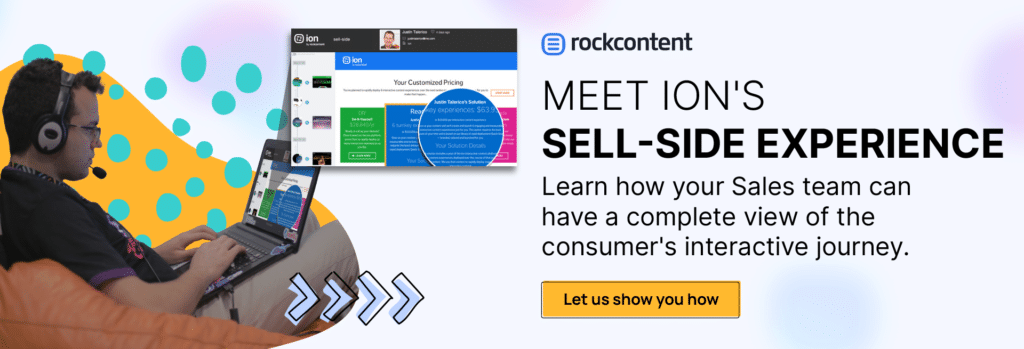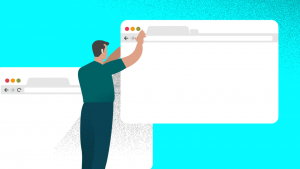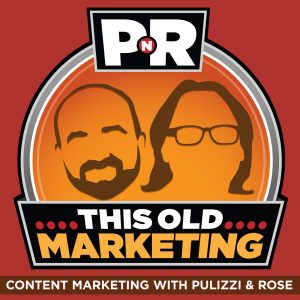Within a market increasingly competitive and looking for consumer attention, it is not enough to offer a better quality product or the best price.
To get people interested in your business and, as a consequence, sell more, it is essential to create a sales enablement strategy.
After all, with so many resources and tools available in the market, it is necessary to take advantage of each one of them to meet the goals and demands of your business.
The main objective of developing a strategy is to prepare the sales team, to create the most favorable scenario for conversion.
However, do you know what it takes to create an efficient sales enablement strategy for your business success and what skills are needed to play a productive role in that process?
Keep on reading to get all your own on the subject and boost your sales performance!
- What is Sales Enablement, and What are Its Benefits?
- Who is Responsible for Sales Enablement?
- What Must a Sales Enablement Professional Bear in Mind?
- What Skills Do You Need to Succeed in This Job?
- How to Create a Sales Enablement Strategy from Scratch?
- What Formats of Content You Can Use in Sales Enablement?
- Bottom Line
Download this post by entering your email below
What is Sales Enablement, and What are Its Benefits?
Before we show you how to apply a sales enablement strategy, it is essential to understand what it means.
In short, it’s collaborative planning that involves different areas of the company to create content and materials that facilitate the work of the salesperson.
In a widely contested market, consumers increasingly value a positive experience in every single contact with companies.
Therefore, the objective of applying a sales enablement strategy is to facilitate and bring closer together the relationship between the two parties, empowering the sales potential of the team.
The main benefit of this strategy is to increase the effectiveness of your company’s actions. The idea is that the salesperson has as much information as possible about the lead, because of the integration between the Sales and Marketing teams.
The alliance between the two areas tends to generate more useful information for your company.
It aims to avoid wasting time and resources on useless content, which, according to a SiriusDecisions survey, represents 60% of what is produced by companies.
Thus, you can offer content that is relevant to the consumer and, in addition to the lead generation work, facilitate your team’s negotiations.
Who is Responsible for Sales Enablement?
As mentioned, sales enablement is a collaborative effort between the marketing and sales team. The marketing team is a crucial source of resources used to sell products or services.
When creating a sales enablement strategy, you need input from both marketing and sales to make it work. For example, you need the marketing department to provide videos, blogs, and product guides that help to support customer interactions.
You also need the sales team to fill in the holes in the marketing effort. They deal directly with customers and have many insights to offer.
What Must a Sales Enablement Professional Bear in Mind?
Sales enablement professionals need to keep in mind their main challenges and tasks. The first of these is to create content that is relevant to the audience and that can be used by the salesperson.
In addition, it is also up to them to prepare the professionals involved in the process to use the solutions correctly.
It’s also the job of this professional to find and use strategies that increase the chances of doing new business, such as cross-selling.
What Skills Do You Need to Succeed in This Job?
Some characteristics are fundamental for the professional who assumes this position, so they must be trained to improve the performance of the sales team.
Here are the five most essential skills for those who want to succeed in sales enablement:
Be a good communicator
Communication is fundamental for the professional responsible for implementing a sales enablement strategy to be successful. After all, he needs to deal with numerous professionals and make connections between different sectors of the company.
Communication, therefore, must be as transparent as possible to ensure that everyone understands their roles.
Develop organizational skills
It is necessary to organize all the required functions, so the sectors work in an integrated way, avoiding rework and planning errors that harm the whole strategy.
Be a data-driven thinker
It is essential to rely on technology and the enormous amount of information generated by a company.
Therefore, a necessary skill to succeed in the function is to be data-driven, that is, to use data to take more precise and efficient decisions, always based on detailed studies and analysis.

Get along with the team
Whether onboarding a new member or getting the most out of each salesperson, it’s essential to know how to deal with who is part of your team.
The professional responsible for implementing the sales enablement strategy needs to manage people well.
Always look for improvements
In other words, it involves not being satisfied with the achieved results and constantly looking for tools, solutions, and ideas that can make the work done even more efficiently and accurately.
In such a competitive market, this is a very important skill.
How to Create a Sales Enablement Strategy from Scratch?
How can you create and apply an efficient sales enablement strategy within your company? To help you do that, we will present below a step-by-step guide with all the tips and points to look at if you want to start your own strategy from scratch and get more sales.
Step 1 — Set goals
The first step in implementing an efficient sales enablement strategy is to determine your objectives with these actions.
In other words, do an in-depth analysis and find out errors, failures, and difficulties. Then, think about the situations you intend to improve.
Step 2 — Talk to the sales team
Next, it’s time to understand the difficulties of the department that will benefit most from the implementation of this strategy: the sales team.
Thus, talk to them and identify what you can do to improve the sales approach and, of course, to increase sales. They will give you insights to make your strategy really efficient.
Step 3 — Understand your audience’s behavior
Understanding the behavior of your audience is another fundamental point. It involves not only demographic data and information but also what they’re looking for and their pain points.
Thus, find out what gets their attention and solves their problems, which will increase the chances of selling.
Step 4 — Don’t forget the customer journey
It is also important to set up your sales enablement strategy in synchrony with the customer journey. Analyze the sales funnel and bear in mind your leads’ needs at the moment.
As a consequence, you will also be able to identify more precisely which contents are the most appropriate.
Step 5 — Select content
Now it’s time to determine what content you will use in the sales enablement strategy. What will be efficient at each touchpoint?
How will the salesperson use this content to further the conversation and increase the prospect’s chances of making a purchase?
Step 6 — Prepare the team to work
When you finish defining your strategy, prepare all professionals to put these actions into practice. Marketing professionals, for example, must create content with a specific objective.
At the same time, salespeople need to understand that they should always be analyzing their conversations to identify areas of improvement.
Step 7 — Take your tools
The next challenge is to gather all the tools you’ll need to put your sales enablement strategy into action. What resources and solutions can be used to facilitate human work?
These points need to be carefully evaluated, especially to choose useful tools for your goals.
Step 8 — Analyze
Even when the strategy is in place, the work is still far from being finished. Now is the time to regularly monitor the results.
What difficulties came up? The analysis needs to be constant.
What Formats of Content You Can Use in Sales Enablement?
Now that you know what a sales enablement strategy is, why it is important, and how to implement it, how about checking out some formats of content you could use?
Content for lead generation
The goal at this stage is to get the user interested in your company and help them to solve their problems. To enhance lead generation, you can write blog posts, white papers, and case studies.
Other forms of lead generation content include:
- E-Books – Marketers often make e-books downloadable in exchange for contact information.
- Courses or webinars – Potential customers often crave information. Courses allow them to learn something constructive. To sign up, they must provide contact information like an email address.
- Demos or freemiums – Demos and freemiums, like trial subscriptions, allow potential buyers to try something out. It also gives salespeople a way to contact them to discuss the experience.
- Contests – Everyone likes to win something. They will often give their contact details to take the chance.
- Guides – Guides provide instructions on how to do things in depth. For example, a hardware store may provide a guide to building a deck and then offer the supplies needed for it. Downloadable guides will also provide contact information.
- Templates – Templates give readers the infrastructure to create forms like calendars or presentations. Like most things downloadable, they need to provide contact information to gain access.
- White papers – White papers are more formal and informative than e-books. They are often academic and contain statistical data on a subject relevant to the ideal buyer. They can download the white paper in exchange for contact information.
Interactive content can capture what buyers are interested in and worried about. Then, Ion can collate that data to give the sales team a more comprehensive and easy-to-understand view of their buyer.
The objective of a sales enablement strategy is to give the sales team tools they can use to get conversions. That takes input from both marketing and sales, though.
It is common to assume marketers are responsible for creating the content that gathers information, but the sales team should contribute too.
Content for team support
As we’ve said, it’s important to prepare your team to handle sales, once only 16% of salespeople say they’re prepared for the job, according to IDC research, which shows you need support.
To do so, the most appropriate type of content are forms and spreadsheets containing information about competitors’ performance.
Content for sales conversions
Salespeople can use interactive content to understand their buyers and steer their journey toward conversion. Quizzes, for example, answer questions the sales team can use to profile their ideal buyer and follow their journey.
Surveys can show pain points that might stand in the way of a sales conversion. E-Books and white papers can tell the sales team what information matters most to their potential buyer.
It’s a common myth that the marketing department develops content, and the sales department uses it to drive sales. While it is true that the marketing team’s primary role is content development, they need to do it in collaboration with the sales department. It is a cause-and-effect concept.
Marketing creates content. Sales try to convert leads using it. If they work separately, there is no learning process. The better approach is for these two critical departments to collaborate on content and figure out what is effective and what isn’t.
Sales can contribute information that marketing can use about buyer behaviors and the effectiveness of current resources. Marketing can ask questions and learn from the information they get from sales.
An effective sales enablement strategy will increase the success rate in both areas using data and tools that help define content. That’s why Ion exists!
Bottom Line
Interactive marketing resources are growing in popularity because they work.
From e-books to quizzes to cost calculators, they generate data that helps to define the buyer and the questions they look to answer as part of the buyer’s journey.
Interactive marketing takes data analysis to the next level. It goes beyond the current analysis that marketers and salespeople do, such as page turns and ad clicks. That’s where Ion can help.
Understanding these interactive tools isn’t always straightforward. The data can seem to run together.
Ion pulls data from interactive marketing content and collates it into an easy-to-understand visual tool that sales can use to understand their leads’ behavior and buying process.
Request your demon and learn more about Sell-Side Experience offered by Ion today!









